
BAROQUE
The Baroque style originated in Rome around the 1600’s . It was the primary style of art between the Mannersim and Rococo movement. It’s a complex style based on high theatrics and drama that envokes emotional states by appealing to the senses. Some of its famous qualities are its richness in colors, movement, tension and emotional exuberance. It has many religious undertones as well, mostly depicted towards the Catholic Church. This made it very unpopular with the Protestant churches and banned in Holland and Britain. Baroque also is found in many sculptures and furniture as well.
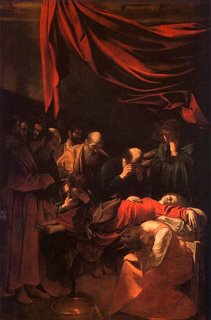 (Caravaggio, The Death of the Virgin, 1605-06)
(Caravaggio, The Death of the Virgin, 1605-06)
The formal qualities in The Death of the Virgin are extreme. It was the largest painting that Caravaggio ever produced. It was 369x 245cm! The painting is severe, sad and very still. The different shades of light show how the light is coming in at different angels and casts shadows. It also highlights the virgin in particular. The shading brings out the glare on the balding men’s head as well. Red, orange and dark green are the predominant colors to produce a very solemn mood. 
One piece that very much the exemplifies the theatric element of the Baroque period is the “The Ecstasy of St. Theresa”, sculpted by Gianlorenzo Bernini 1645-1652.
The work depicts a paradox, one of joy and anguish experienced at the same time, this theme of paradox is an important characteristic of the Baroque style. The artist used “every device available to him to dramatize the scene.” (Sayre p.471) The sculpture is spotlighted by a tiny window above so that the whole scene seems to glow. The bronze rays appear as if they were painted rays from heaven. Here the theatrics of Baroque are quite evident.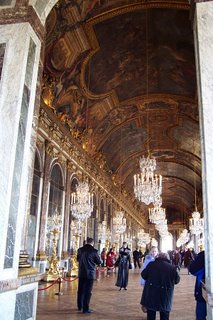 (THE PALACE OF VERSAILLES)
(THE PALACE OF VERSAILLES)
This palace is a great example of the Baroques architecture. The Palace of Versailles was the official residence of the Kings of France from 1682 until 1790. It was originally a hunting lodge, built in 1624, by Louis XIII. It was expanded by Louis XIV beginning in 1669. He used it as a little lodge as a secret refuge for his amorous trysts with the lovely Louise de la Valliere and built a fairy tale park around it. The courtyard contained perhaps the biggest slab of marble in its time and was extremely costly but never short on style. It also had a hall of mirrors which was even more expensive than the marble at that time. The gardens are extremely large and very lush surrounding the castle. The ceiling contained many great fresco paintings. Most of the furnishing were destroyed during the French revolution but later restored by Napolean.
(Rembrandt van Rijn, “Resurrection of Christ”)
Baroque came to be as a response to the growing popularity of Protestantism. Its style of drama, theatrics and tendency to evoke emotion were meant to attract the people back to the “reinvigorated Catholic church.” (webmuseum) As the Baroque style spread across Europe and into Protestant areas, the religious examples of art were banned, and new subjects such as landscapes became the focus. These artists were now not painting for the church, but rather for the international markets. With this new subject matter, people began to realize that what is spiritual is not found only in church, but in everyday life. Also, art began to take on new meanings. For example, Louis XIV began using art as a propaganda tool rather than for aesthetic beauty or religious expression. 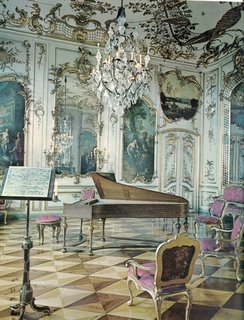
(Baroque Music Room )
This music room is a great example of the Baroque style. We chose this painting as it includes the painting aspect but the overall architecture and furniture as well. The colors have a very classic but serious look. The architecture allows for high fresco painted ceilings with lots of light as well. The chairs also have an elegant and royalty look to them that follow the overall form of the room. This is definitely a place where both royalty and the common people could truly appreciate. 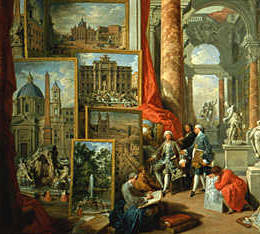 (Giovanni Paolo Panini)
(Giovanni Paolo Panini)
All of the pieces we chose are excellent examples of Baroque style from the Baroque period. The use of color and light along with evoking a sense of drama and theatrics are characteristics found in Baroque art, and to an extent, characteristics in all the works we have shown. They all clearly deviate from the classical principles of preceding the style, this is true in the paintings and the architecture. All of these aspects make Baroque a unique and distinguishable style, obviously found in-between the mannerism and rococo periods.
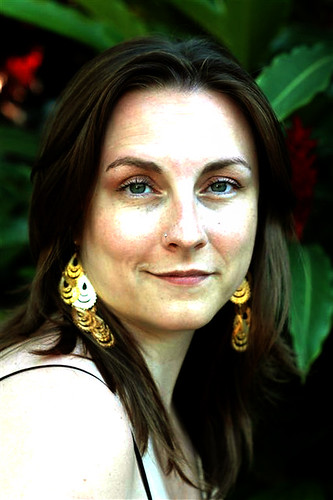



1 comment:
Hello, The Music room is actually not Baroque, this would be a Rococo Interior. You can tell this by the guilded boiserie, the panels illustrating Ovid's Metamorphasis (Baroque would have been something serious like war paintings not mythological characters) ormulu-mounted furniture and the filagree forms. If it were baroque there would be more straight lines, not curves, more columns, not panels.
Post a Comment